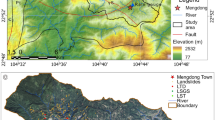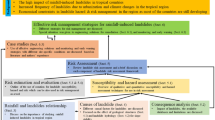Abstract
In order to establish a rapid method for regional slope stability analysis under rainfall, matric suction and seepage force were taken into account after obtaining explicit solution of infiltration depth. Moreover, simplified analysis model under 3D condition was put forward based on identification and division of slope units, as well as modification of sliding direction of each column. The result shows that explicit solution of infiltration depth is of good precision; for the given model, safety factors without taking seepage force into account are 1.82–2.94 times higher; the stagnation point of slope angle is located approximately in the range of (45°, 50°); the safety factor changes insignificantly when wetting front is deeper than 2 m; when matric suction changes in the specified range, the maximum variations of safety factor are less than 0.5, which proves that matric suction plays an insignificant role in maintaining slope stability compared to the slope angle and infiltration depth. Incorporated with geographic information system, a practical application of regional slope stability assessment verifies the applicability of the proposed method.
Similar content being viewed by others
References
LEE M L, NURLY G. A simple model for preliminary evaluation of rainfall-induced slope instability [J]. Engineering Geology, 2009, 108: 272–285.
KIM J, JEONG S. Influence of rainfall-induced wetting on the stability of slopes in weathered soils [J]. Engineering Geology, 2004, 75: 251–262.
ZHOU Zhong, WANG Hong-gui, FU He-lin. Influences of rainfall infiltration on stability of accumulation slope by in-situ monitoring test [J]. Journal of Central South University of Technology, 2009, 16(2): 297–302.
RICHARD M. Landslide triggering by rain infiltration [J]. Water Resources Research, 2000, 36(7): 1897–1910.
SUNG E. Infiltration analysis to evaluate the surficial stability of two-layered slopes considering rainfall characteristics [J]. Engineering Geology, 2009, 105: 32–43.
MONTGOMERY D R, DIETRICH W E. A physically-based model for the topographic control on shallow landsliding [J]. Water Resources Research, 1994, 30(4): 1153–1171.
WU W M, SIDLE R C. A distributed slope stability model for steep forested basins [J]. Water Resources Research, 1995, 31(8): 2097–2110.
BORGA M, FONTANA G D. Shallow landslide hazard assessment using a physically based model and digital elevation data [J]. Environmental Geology, 1998, 35(2/3): 81–88.
BAUM R L, SAVAGE W Z, GODT J W. TRIGRS: A Fortran program for transient rainfall infiltration and grid-based slope-stability analysis [R]. U.S. Geological Survey Open-File Report, 2002.
CASADEI M, DEITRICH W E, MILLER N L. Testing a model for predicting the timing and location of shallow landslide initiation in soil-mantled landscapes [J]. Earth Surface Processes and Landforms, 2003, 28: 925–950.
SAVAGE W Z, GODT J W, BAUM R L. A model for spatially and temporally distributed landslide initiation by rainfall infiltration. [M]// RICKENMANN D, CHEN L, Eds. Debris flow hazards mitigation: Mechanics, prediction and assessment. Rotterdam: Mill Press, 2003.
HARP E L, MICHAEL J A, LAPRADE W T. Shallow-landslide hazard map of Seattle, Washington [R]. U.S. Geological Survey Open-File Report, 2006.
GODT J W, BAUM R L. Transient deterministic shallow landslide modeling: Requirements for susceptibility and hazard assessments in a GIS framework [J]. Engineering Geology, 2008, 102: 214–226.
CARRARA A, CARDINALI M, GUZZETTI F. GIS technology in mapping landslide hazard. Geographical information systems in assessing natural hazards [M]. Dordrecht: Kluwer Academic Publisher, 1995.
QIU C, ESAKI T, ZHOU G Y, XIE M W. Development of GIS-based intelligent slope units identifying tool for 3D slope stability evaluation [C]// International Workshop on Earth Science and Technology. Kyushu University, Japan, 2003: 115–122.
GAVIN K, XUE J F. A simple method to analyze infiltration into unsaturated soil slopes [J]. Computers and Geotechnics, 2008, 35: 223–230.
PHILIP J R. Reply to “comments on “steady infiltration from spherical cavities”” [J]. Soil Sci, 1985, 49: 788–789.
SWARTZENDRUBER D. Derivation of a two-term infiltration equation from the Green-Ampt model [J]. Journal of Hydrology, 2000, 236: 247–251.
WHITE I, SULLY M J. Macroscopic and microscopic capillary length and time scales from field infiltration [J]. Water Resource Research, 1987, 23: 1514–1522.
ZHANG Zhen-hua, PAN Ying-hua, CAI Huan-jie. Approximate explicit solution to infiltration rate of Green-Ampt infiltration formula [J]. System Science and Comprehensive Studies in Agriculture, 2006, 22(4): 308–311. (in Chinese)
FREDLUND D G, RAHARDJO H. Soil mechanics for unsaturated soils [M]. New York: Wiley, 1993.
WU Hong-wei, CHEN Shou-yi, PANG Yu-wei. Parametric study of effects of rain infiltration on unsaturated slopes [J]. Rock and Soil Mechanics, 1999, 20(1): 1–13.
Author information
Authors and Affiliations
Corresponding author
Additional information
Foundation item: Project(kfj110207) supported by Open Fund of Key Laboratory of Road Structure and Material of Ministry of Transport, China
Rights and permissions
About this article
Cite this article
Fang, W., Esaki, T. Rapid assessment of regional superficial landslide under heavy rainfall. J. Cent. South Univ. 19, 2663–2673 (2012). https://doi.org/10.1007/s11771-012-1325-6
Received:
Accepted:
Published:
Issue Date:
DOI: https://doi.org/10.1007/s11771-012-1325-6




